Analysis of the Failure of Murray Darling Water Management Policies
VerifiedAdded on 2023/03/21
|8
|2020
|67
Essay
AI Summary
This essay critically examines the failure of the Murray Darling water management policies, a crucial hydrological system supporting Australia's economy and ecology. The Murray Darling Basin Plan, enacted in 2012, aimed to restore the river's health, but faced challenges related to water allocation and environmental demands. The essay delves into the policy's shortcomings, exploring factors contributing to its failure, including the over-exploitation of water resources, the impact on the ecosystem, and the contentious public debate surrounding water management. It also discusses the importance of ecologically sustainable development, sustainable technologies, and community efforts for the restoration of the Murray Darling Basin. The essay concludes by emphasizing the need for effective management, strict environmental legislation, and the role of the current generation in restoring the basin's glory.
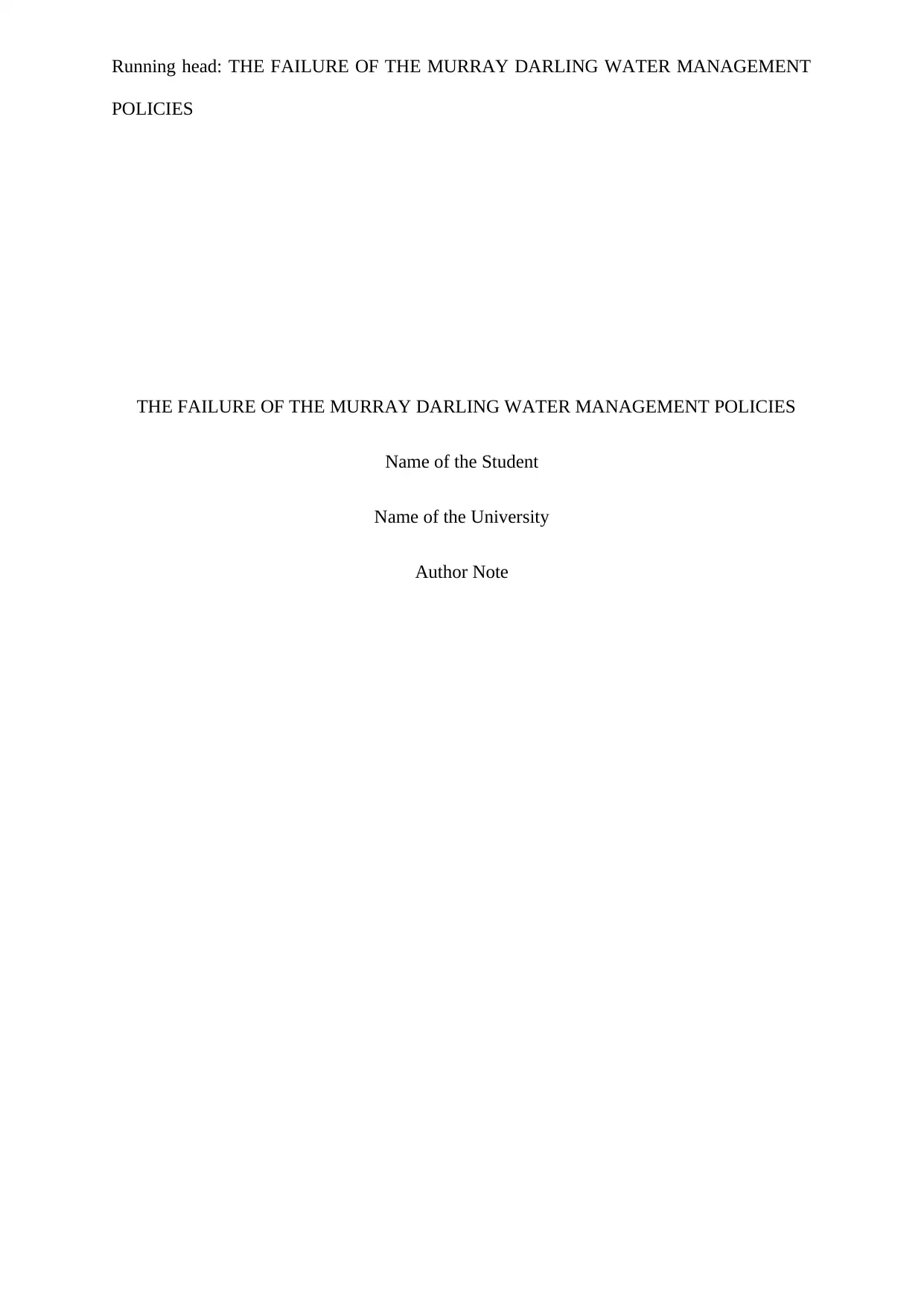
Running head: THE FAILURE OF THE MURRAY DARLING WATER MANAGEMENT
POLICIES
THE FAILURE OF THE MURRAY DARLING WATER MANAGEMENT POLICIES
Name of the Student
Name of the University
Author Note
POLICIES
THE FAILURE OF THE MURRAY DARLING WATER MANAGEMENT POLICIES
Name of the Student
Name of the University
Author Note
Paraphrase This Document
Need a fresh take? Get an instant paraphrase of this document with our AI Paraphraser
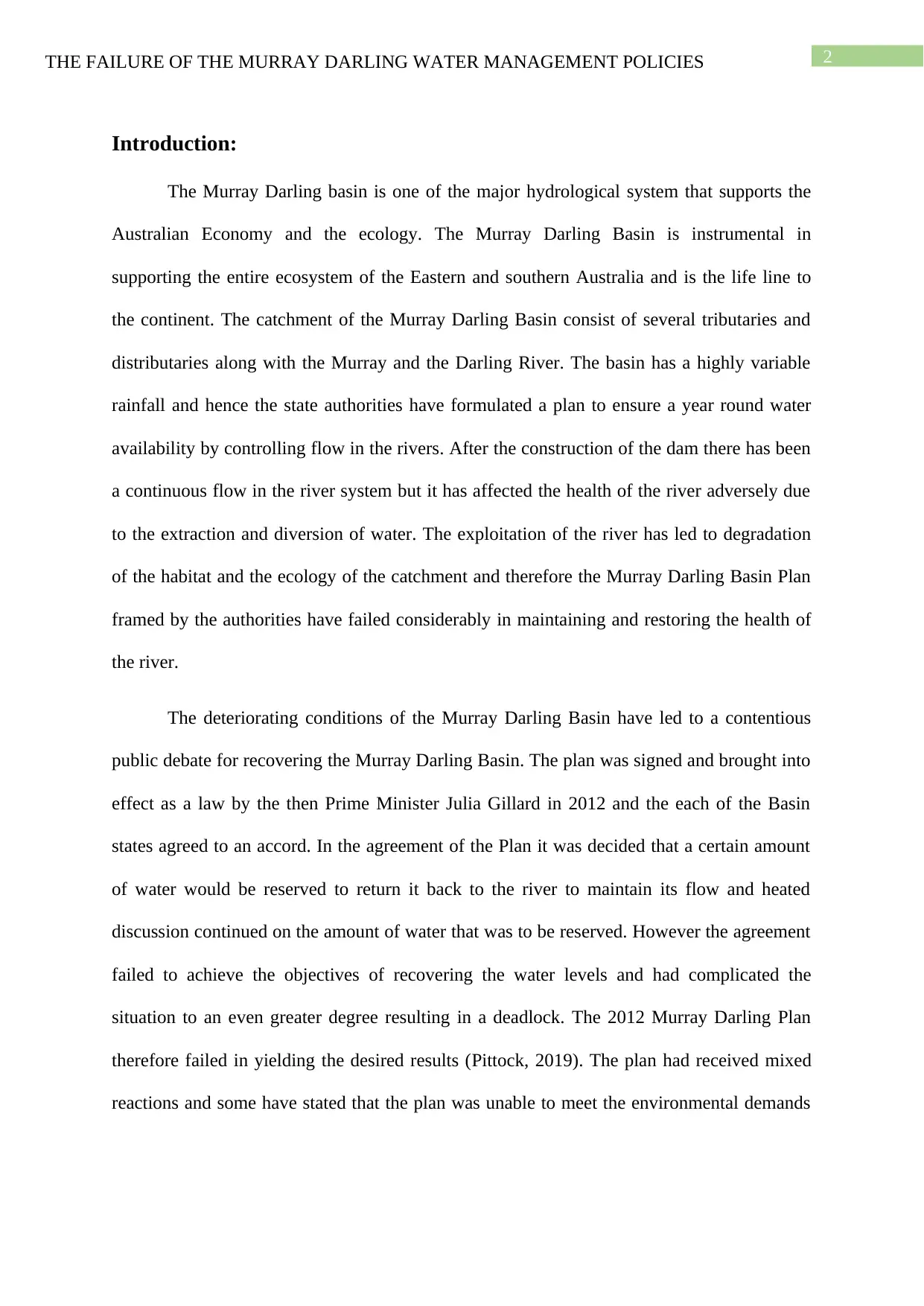
2THE FAILURE OF THE MURRAY DARLING WATER MANAGEMENT POLICIES
Introduction:
The Murray Darling basin is one of the major hydrological system that supports the
Australian Economy and the ecology. The Murray Darling Basin is instrumental in
supporting the entire ecosystem of the Eastern and southern Australia and is the life line to
the continent. The catchment of the Murray Darling Basin consist of several tributaries and
distributaries along with the Murray and the Darling River. The basin has a highly variable
rainfall and hence the state authorities have formulated a plan to ensure a year round water
availability by controlling flow in the rivers. After the construction of the dam there has been
a continuous flow in the river system but it has affected the health of the river adversely due
to the extraction and diversion of water. The exploitation of the river has led to degradation
of the habitat and the ecology of the catchment and therefore the Murray Darling Basin Plan
framed by the authorities have failed considerably in maintaining and restoring the health of
the river.
The deteriorating conditions of the Murray Darling Basin have led to a contentious
public debate for recovering the Murray Darling Basin. The plan was signed and brought into
effect as a law by the then Prime Minister Julia Gillard in 2012 and the each of the Basin
states agreed to an accord. In the agreement of the Plan it was decided that a certain amount
of water would be reserved to return it back to the river to maintain its flow and heated
discussion continued on the amount of water that was to be reserved. However the agreement
failed to achieve the objectives of recovering the water levels and had complicated the
situation to an even greater degree resulting in a deadlock. The 2012 Murray Darling Plan
therefore failed in yielding the desired results (Pittock, 2019). The plan had received mixed
reactions and some have stated that the plan was unable to meet the environmental demands
Introduction:
The Murray Darling basin is one of the major hydrological system that supports the
Australian Economy and the ecology. The Murray Darling Basin is instrumental in
supporting the entire ecosystem of the Eastern and southern Australia and is the life line to
the continent. The catchment of the Murray Darling Basin consist of several tributaries and
distributaries along with the Murray and the Darling River. The basin has a highly variable
rainfall and hence the state authorities have formulated a plan to ensure a year round water
availability by controlling flow in the rivers. After the construction of the dam there has been
a continuous flow in the river system but it has affected the health of the river adversely due
to the extraction and diversion of water. The exploitation of the river has led to degradation
of the habitat and the ecology of the catchment and therefore the Murray Darling Basin Plan
framed by the authorities have failed considerably in maintaining and restoring the health of
the river.
The deteriorating conditions of the Murray Darling Basin have led to a contentious
public debate for recovering the Murray Darling Basin. The plan was signed and brought into
effect as a law by the then Prime Minister Julia Gillard in 2012 and the each of the Basin
states agreed to an accord. In the agreement of the Plan it was decided that a certain amount
of water would be reserved to return it back to the river to maintain its flow and heated
discussion continued on the amount of water that was to be reserved. However the agreement
failed to achieve the objectives of recovering the water levels and had complicated the
situation to an even greater degree resulting in a deadlock. The 2012 Murray Darling Plan
therefore failed in yielding the desired results (Pittock, 2019). The plan had received mixed
reactions and some have stated that the plan was unable to meet the environmental demands
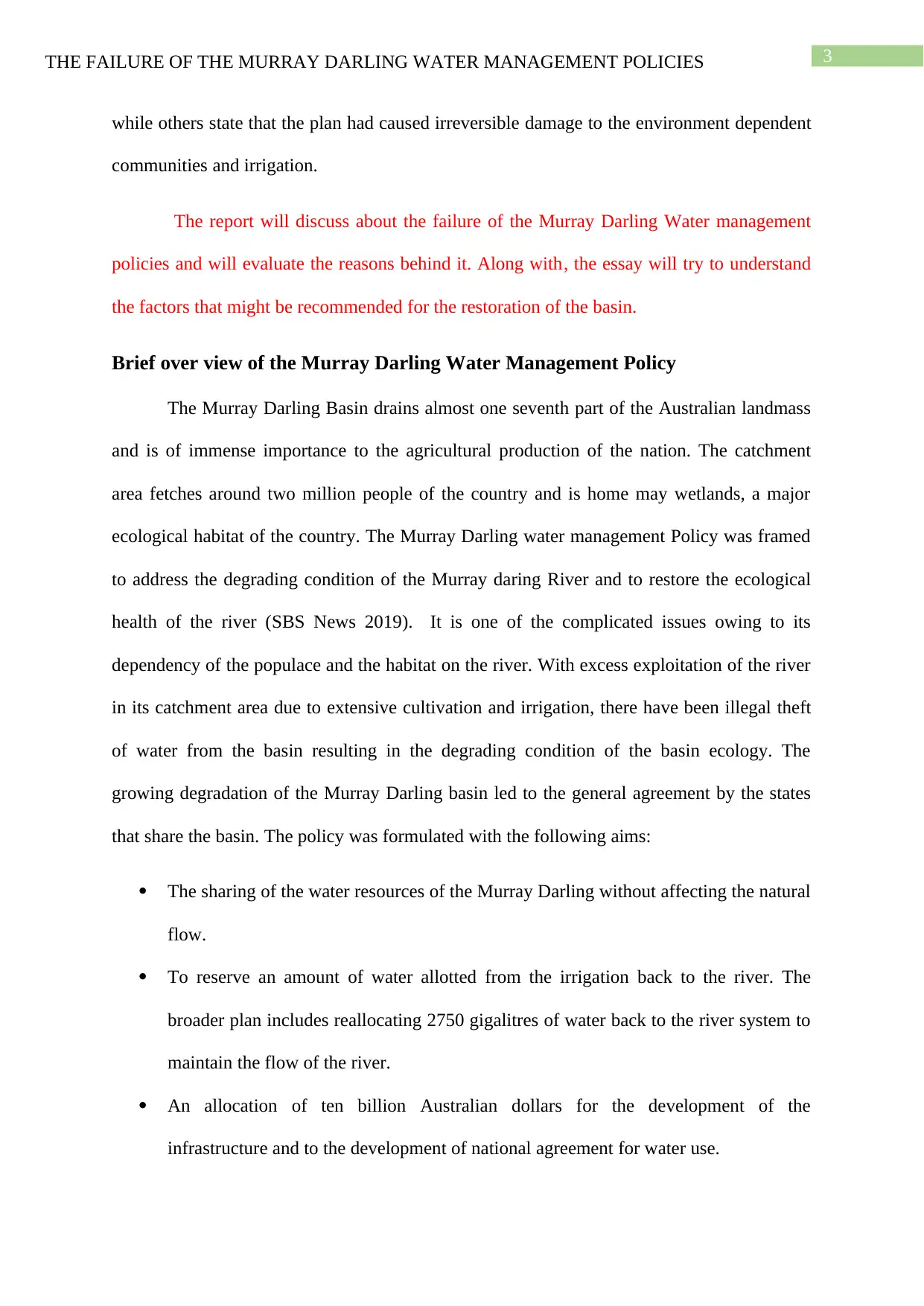
3THE FAILURE OF THE MURRAY DARLING WATER MANAGEMENT POLICIES
while others state that the plan had caused irreversible damage to the environment dependent
communities and irrigation.
The report will discuss about the failure of the Murray Darling Water management
policies and will evaluate the reasons behind it. Along with, the essay will try to understand
the factors that might be recommended for the restoration of the basin.
Brief over view of the Murray Darling Water Management Policy
The Murray Darling Basin drains almost one seventh part of the Australian landmass
and is of immense importance to the agricultural production of the nation. The catchment
area fetches around two million people of the country and is home may wetlands, a major
ecological habitat of the country. The Murray Darling water management Policy was framed
to address the degrading condition of the Murray daring River and to restore the ecological
health of the river (SBS News 2019). It is one of the complicated issues owing to its
dependency of the populace and the habitat on the river. With excess exploitation of the river
in its catchment area due to extensive cultivation and irrigation, there have been illegal theft
of water from the basin resulting in the degrading condition of the basin ecology. The
growing degradation of the Murray Darling basin led to the general agreement by the states
that share the basin. The policy was formulated with the following aims:
The sharing of the water resources of the Murray Darling without affecting the natural
flow.
To reserve an amount of water allotted from the irrigation back to the river. The
broader plan includes reallocating 2750 gigalitres of water back to the river system to
maintain the flow of the river.
An allocation of ten billion Australian dollars for the development of the
infrastructure and to the development of national agreement for water use.
while others state that the plan had caused irreversible damage to the environment dependent
communities and irrigation.
The report will discuss about the failure of the Murray Darling Water management
policies and will evaluate the reasons behind it. Along with, the essay will try to understand
the factors that might be recommended for the restoration of the basin.
Brief over view of the Murray Darling Water Management Policy
The Murray Darling Basin drains almost one seventh part of the Australian landmass
and is of immense importance to the agricultural production of the nation. The catchment
area fetches around two million people of the country and is home may wetlands, a major
ecological habitat of the country. The Murray Darling water management Policy was framed
to address the degrading condition of the Murray daring River and to restore the ecological
health of the river (SBS News 2019). It is one of the complicated issues owing to its
dependency of the populace and the habitat on the river. With excess exploitation of the river
in its catchment area due to extensive cultivation and irrigation, there have been illegal theft
of water from the basin resulting in the degrading condition of the basin ecology. The
growing degradation of the Murray Darling basin led to the general agreement by the states
that share the basin. The policy was formulated with the following aims:
The sharing of the water resources of the Murray Darling without affecting the natural
flow.
To reserve an amount of water allotted from the irrigation back to the river. The
broader plan includes reallocating 2750 gigalitres of water back to the river system to
maintain the flow of the river.
An allocation of ten billion Australian dollars for the development of the
infrastructure and to the development of national agreement for water use.
⊘ This is a preview!⊘
Do you want full access?
Subscribe today to unlock all pages.

Trusted by 1+ million students worldwide
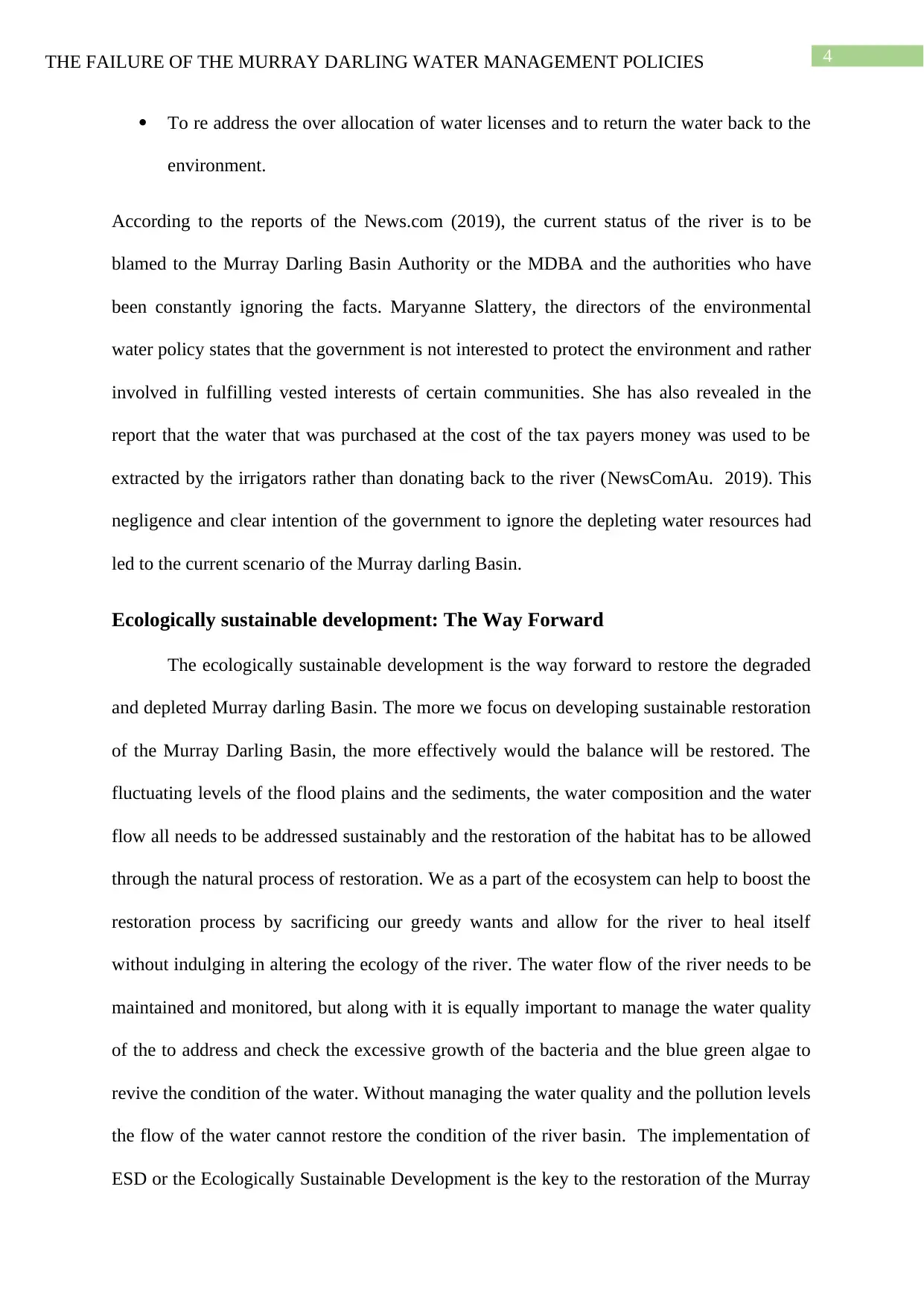
4THE FAILURE OF THE MURRAY DARLING WATER MANAGEMENT POLICIES
To re address the over allocation of water licenses and to return the water back to the
environment.
According to the reports of the News.com (2019), the current status of the river is to be
blamed to the Murray Darling Basin Authority or the MDBA and the authorities who have
been constantly ignoring the facts. Maryanne Slattery, the directors of the environmental
water policy states that the government is not interested to protect the environment and rather
involved in fulfilling vested interests of certain communities. She has also revealed in the
report that the water that was purchased at the cost of the tax payers money was used to be
extracted by the irrigators rather than donating back to the river (NewsComAu. 2019). This
negligence and clear intention of the government to ignore the depleting water resources had
led to the current scenario of the Murray darling Basin.
Ecologically sustainable development: The Way Forward
The ecologically sustainable development is the way forward to restore the degraded
and depleted Murray darling Basin. The more we focus on developing sustainable restoration
of the Murray Darling Basin, the more effectively would the balance will be restored. The
fluctuating levels of the flood plains and the sediments, the water composition and the water
flow all needs to be addressed sustainably and the restoration of the habitat has to be allowed
through the natural process of restoration. We as a part of the ecosystem can help to boost the
restoration process by sacrificing our greedy wants and allow for the river to heal itself
without indulging in altering the ecology of the river. The water flow of the river needs to be
maintained and monitored, but along with it is equally important to manage the water quality
of the to address and check the excessive growth of the bacteria and the blue green algae to
revive the condition of the water. Without managing the water quality and the pollution levels
the flow of the water cannot restore the condition of the river basin. The implementation of
ESD or the Ecologically Sustainable Development is the key to the restoration of the Murray
To re address the over allocation of water licenses and to return the water back to the
environment.
According to the reports of the News.com (2019), the current status of the river is to be
blamed to the Murray Darling Basin Authority or the MDBA and the authorities who have
been constantly ignoring the facts. Maryanne Slattery, the directors of the environmental
water policy states that the government is not interested to protect the environment and rather
involved in fulfilling vested interests of certain communities. She has also revealed in the
report that the water that was purchased at the cost of the tax payers money was used to be
extracted by the irrigators rather than donating back to the river (NewsComAu. 2019). This
negligence and clear intention of the government to ignore the depleting water resources had
led to the current scenario of the Murray darling Basin.
Ecologically sustainable development: The Way Forward
The ecologically sustainable development is the way forward to restore the degraded
and depleted Murray darling Basin. The more we focus on developing sustainable restoration
of the Murray Darling Basin, the more effectively would the balance will be restored. The
fluctuating levels of the flood plains and the sediments, the water composition and the water
flow all needs to be addressed sustainably and the restoration of the habitat has to be allowed
through the natural process of restoration. We as a part of the ecosystem can help to boost the
restoration process by sacrificing our greedy wants and allow for the river to heal itself
without indulging in altering the ecology of the river. The water flow of the river needs to be
maintained and monitored, but along with it is equally important to manage the water quality
of the to address and check the excessive growth of the bacteria and the blue green algae to
revive the condition of the water. Without managing the water quality and the pollution levels
the flow of the water cannot restore the condition of the river basin. The implementation of
ESD or the Ecologically Sustainable Development is the key to the restoration of the Murray
Paraphrase This Document
Need a fresh take? Get an instant paraphrase of this document with our AI Paraphraser
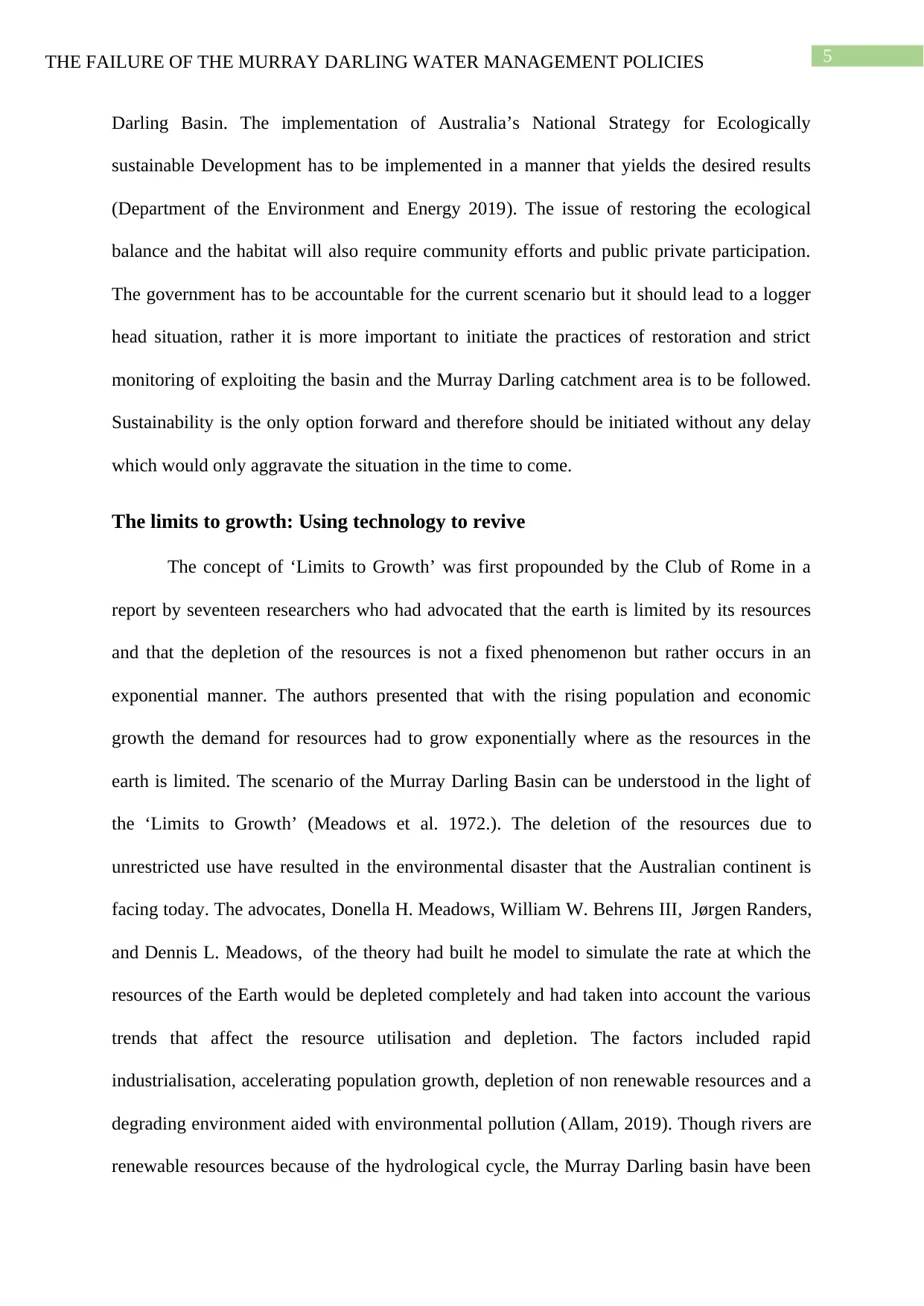
5THE FAILURE OF THE MURRAY DARLING WATER MANAGEMENT POLICIES
Darling Basin. The implementation of Australia’s National Strategy for Ecologically
sustainable Development has to be implemented in a manner that yields the desired results
(Department of the Environment and Energy 2019). The issue of restoring the ecological
balance and the habitat will also require community efforts and public private participation.
The government has to be accountable for the current scenario but it should lead to a logger
head situation, rather it is more important to initiate the practices of restoration and strict
monitoring of exploiting the basin and the Murray Darling catchment area is to be followed.
Sustainability is the only option forward and therefore should be initiated without any delay
which would only aggravate the situation in the time to come.
The limits to growth: Using technology to revive
The concept of ‘Limits to Growth’ was first propounded by the Club of Rome in a
report by seventeen researchers who had advocated that the earth is limited by its resources
and that the depletion of the resources is not a fixed phenomenon but rather occurs in an
exponential manner. The authors presented that with the rising population and economic
growth the demand for resources had to grow exponentially where as the resources in the
earth is limited. The scenario of the Murray Darling Basin can be understood in the light of
the ‘Limits to Growth’ (Meadows et al. 1972.). The deletion of the resources due to
unrestricted use have resulted in the environmental disaster that the Australian continent is
facing today. The advocates, Donella H. Meadows, William W. Behrens III, Jørgen Randers,
and Dennis L. Meadows, of the theory had built he model to simulate the rate at which the
resources of the Earth would be depleted completely and had taken into account the various
trends that affect the resource utilisation and depletion. The factors included rapid
industrialisation, accelerating population growth, depletion of non renewable resources and a
degrading environment aided with environmental pollution (Allam, 2019). Though rivers are
renewable resources because of the hydrological cycle, the Murray Darling basin have been
Darling Basin. The implementation of Australia’s National Strategy for Ecologically
sustainable Development has to be implemented in a manner that yields the desired results
(Department of the Environment and Energy 2019). The issue of restoring the ecological
balance and the habitat will also require community efforts and public private participation.
The government has to be accountable for the current scenario but it should lead to a logger
head situation, rather it is more important to initiate the practices of restoration and strict
monitoring of exploiting the basin and the Murray Darling catchment area is to be followed.
Sustainability is the only option forward and therefore should be initiated without any delay
which would only aggravate the situation in the time to come.
The limits to growth: Using technology to revive
The concept of ‘Limits to Growth’ was first propounded by the Club of Rome in a
report by seventeen researchers who had advocated that the earth is limited by its resources
and that the depletion of the resources is not a fixed phenomenon but rather occurs in an
exponential manner. The authors presented that with the rising population and economic
growth the demand for resources had to grow exponentially where as the resources in the
earth is limited. The scenario of the Murray Darling Basin can be understood in the light of
the ‘Limits to Growth’ (Meadows et al. 1972.). The deletion of the resources due to
unrestricted use have resulted in the environmental disaster that the Australian continent is
facing today. The advocates, Donella H. Meadows, William W. Behrens III, Jørgen Randers,
and Dennis L. Meadows, of the theory had built he model to simulate the rate at which the
resources of the Earth would be depleted completely and had taken into account the various
trends that affect the resource utilisation and depletion. The factors included rapid
industrialisation, accelerating population growth, depletion of non renewable resources and a
degrading environment aided with environmental pollution (Allam, 2019). Though rivers are
renewable resources because of the hydrological cycle, the Murray Darling basin have been
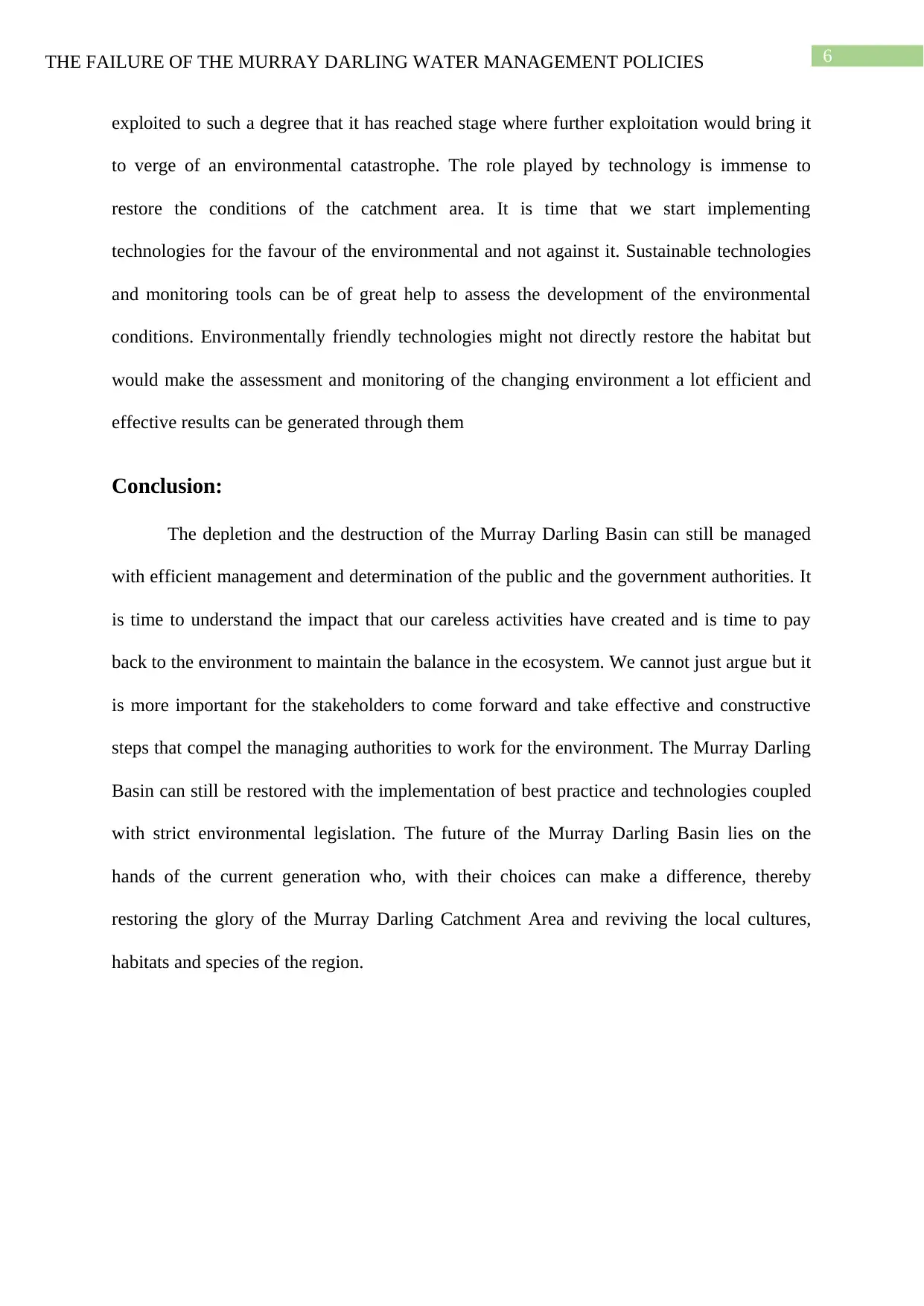
6THE FAILURE OF THE MURRAY DARLING WATER MANAGEMENT POLICIES
exploited to such a degree that it has reached stage where further exploitation would bring it
to verge of an environmental catastrophe. The role played by technology is immense to
restore the conditions of the catchment area. It is time that we start implementing
technologies for the favour of the environmental and not against it. Sustainable technologies
and monitoring tools can be of great help to assess the development of the environmental
conditions. Environmentally friendly technologies might not directly restore the habitat but
would make the assessment and monitoring of the changing environment a lot efficient and
effective results can be generated through them
Conclusion:
The depletion and the destruction of the Murray Darling Basin can still be managed
with efficient management and determination of the public and the government authorities. It
is time to understand the impact that our careless activities have created and is time to pay
back to the environment to maintain the balance in the ecosystem. We cannot just argue but it
is more important for the stakeholders to come forward and take effective and constructive
steps that compel the managing authorities to work for the environment. The Murray Darling
Basin can still be restored with the implementation of best practice and technologies coupled
with strict environmental legislation. The future of the Murray Darling Basin lies on the
hands of the current generation who, with their choices can make a difference, thereby
restoring the glory of the Murray Darling Catchment Area and reviving the local cultures,
habitats and species of the region.
exploited to such a degree that it has reached stage where further exploitation would bring it
to verge of an environmental catastrophe. The role played by technology is immense to
restore the conditions of the catchment area. It is time that we start implementing
technologies for the favour of the environmental and not against it. Sustainable technologies
and monitoring tools can be of great help to assess the development of the environmental
conditions. Environmentally friendly technologies might not directly restore the habitat but
would make the assessment and monitoring of the changing environment a lot efficient and
effective results can be generated through them
Conclusion:
The depletion and the destruction of the Murray Darling Basin can still be managed
with efficient management and determination of the public and the government authorities. It
is time to understand the impact that our careless activities have created and is time to pay
back to the environment to maintain the balance in the ecosystem. We cannot just argue but it
is more important for the stakeholders to come forward and take effective and constructive
steps that compel the managing authorities to work for the environment. The Murray Darling
Basin can still be restored with the implementation of best practice and technologies coupled
with strict environmental legislation. The future of the Murray Darling Basin lies on the
hands of the current generation who, with their choices can make a difference, thereby
restoring the glory of the Murray Darling Catchment Area and reviving the local cultures,
habitats and species of the region.
⊘ This is a preview!⊘
Do you want full access?
Subscribe today to unlock all pages.

Trusted by 1+ million students worldwide
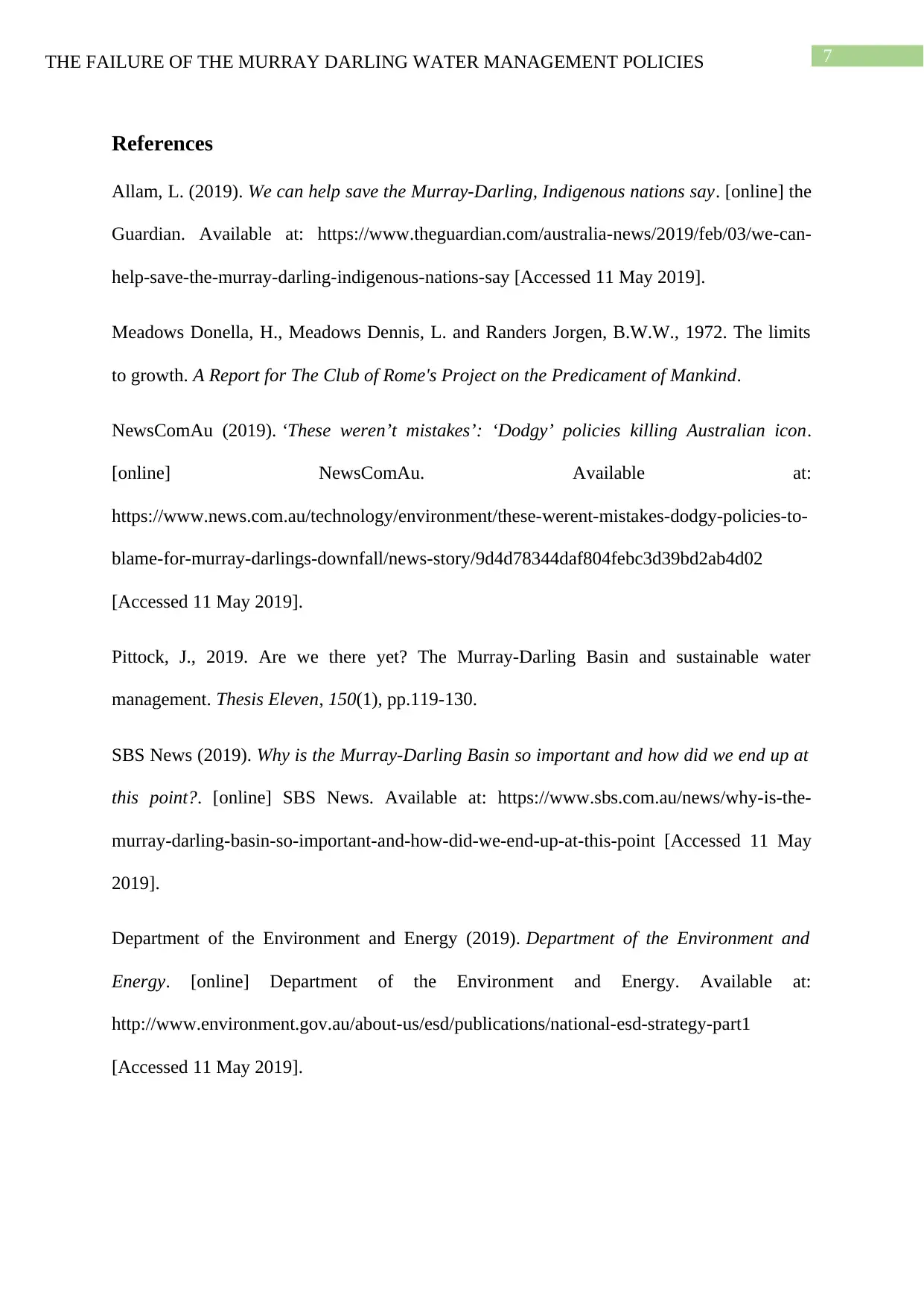
7THE FAILURE OF THE MURRAY DARLING WATER MANAGEMENT POLICIES
References
Allam, L. (2019). We can help save the Murray-Darling, Indigenous nations say. [online] the
Guardian. Available at: https://www.theguardian.com/australia-news/2019/feb/03/we-can-
help-save-the-murray-darling-indigenous-nations-say [Accessed 11 May 2019].
Meadows Donella, H., Meadows Dennis, L. and Randers Jorgen, B.W.W., 1972. The limits
to growth. A Report for The Club of Rome's Project on the Predicament of Mankind.
NewsComAu (2019). ‘These weren’t mistakes’: ‘Dodgy’ policies killing Australian icon.
[online] NewsComAu. Available at:
https://www.news.com.au/technology/environment/these-werent-mistakes-dodgy-policies-to-
blame-for-murray-darlings-downfall/news-story/9d4d78344daf804febc3d39bd2ab4d02
[Accessed 11 May 2019].
Pittock, J., 2019. Are we there yet? The Murray-Darling Basin and sustainable water
management. Thesis Eleven, 150(1), pp.119-130.
SBS News (2019). Why is the Murray-Darling Basin so important and how did we end up at
this point?. [online] SBS News. Available at: https://www.sbs.com.au/news/why-is-the-
murray-darling-basin-so-important-and-how-did-we-end-up-at-this-point [Accessed 11 May
2019].
Department of the Environment and Energy (2019). Department of the Environment and
Energy. [online] Department of the Environment and Energy. Available at:
http://www.environment.gov.au/about-us/esd/publications/national-esd-strategy-part1
[Accessed 11 May 2019].
References
Allam, L. (2019). We can help save the Murray-Darling, Indigenous nations say. [online] the
Guardian. Available at: https://www.theguardian.com/australia-news/2019/feb/03/we-can-
help-save-the-murray-darling-indigenous-nations-say [Accessed 11 May 2019].
Meadows Donella, H., Meadows Dennis, L. and Randers Jorgen, B.W.W., 1972. The limits
to growth. A Report for The Club of Rome's Project on the Predicament of Mankind.
NewsComAu (2019). ‘These weren’t mistakes’: ‘Dodgy’ policies killing Australian icon.
[online] NewsComAu. Available at:
https://www.news.com.au/technology/environment/these-werent-mistakes-dodgy-policies-to-
blame-for-murray-darlings-downfall/news-story/9d4d78344daf804febc3d39bd2ab4d02
[Accessed 11 May 2019].
Pittock, J., 2019. Are we there yet? The Murray-Darling Basin and sustainable water
management. Thesis Eleven, 150(1), pp.119-130.
SBS News (2019). Why is the Murray-Darling Basin so important and how did we end up at
this point?. [online] SBS News. Available at: https://www.sbs.com.au/news/why-is-the-
murray-darling-basin-so-important-and-how-did-we-end-up-at-this-point [Accessed 11 May
2019].
Department of the Environment and Energy (2019). Department of the Environment and
Energy. [online] Department of the Environment and Energy. Available at:
http://www.environment.gov.au/about-us/esd/publications/national-esd-strategy-part1
[Accessed 11 May 2019].
Paraphrase This Document
Need a fresh take? Get an instant paraphrase of this document with our AI Paraphraser
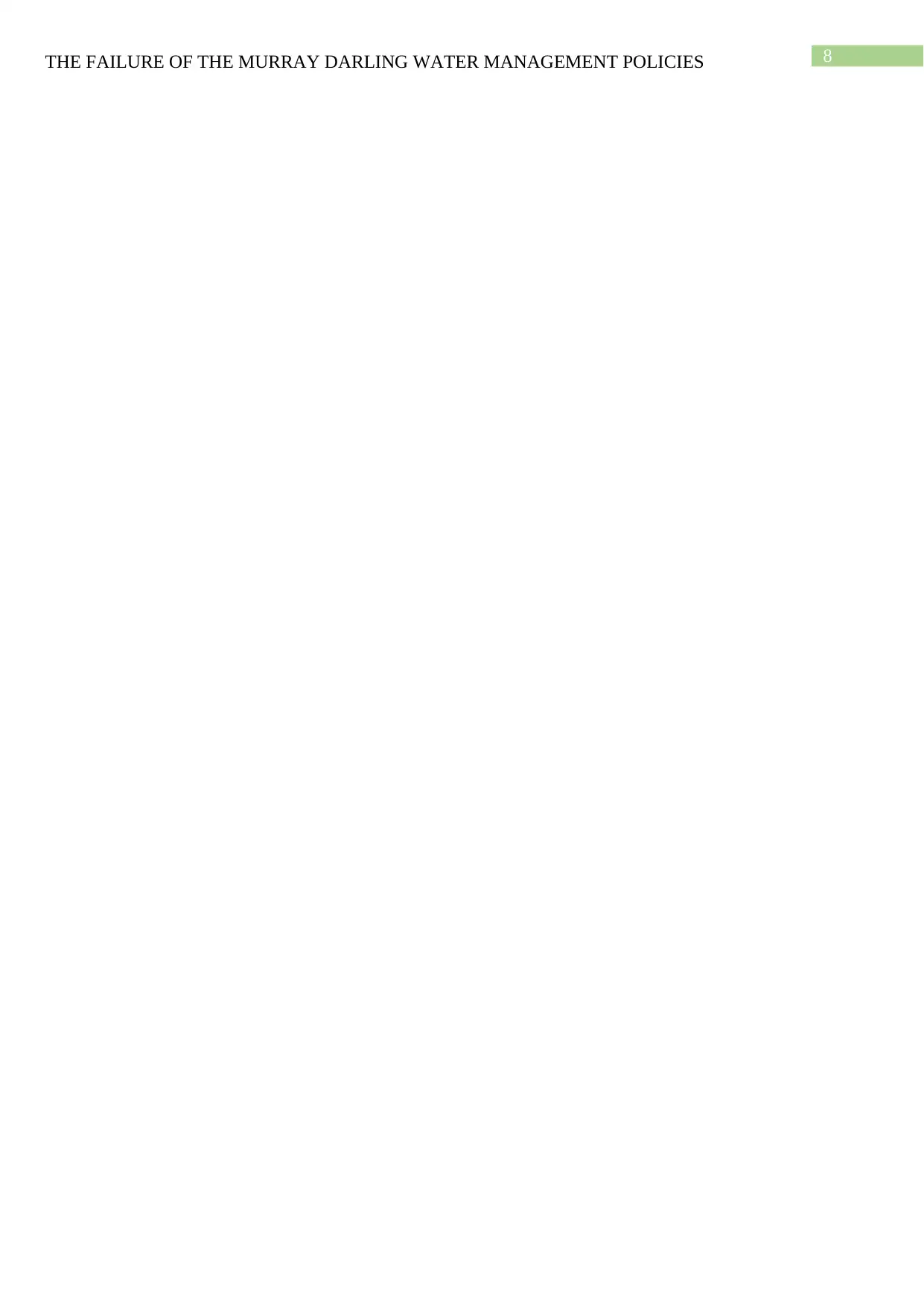
8THE FAILURE OF THE MURRAY DARLING WATER MANAGEMENT POLICIES
1 out of 8
Related Documents
Your All-in-One AI-Powered Toolkit for Academic Success.
+13062052269
info@desklib.com
Available 24*7 on WhatsApp / Email
![[object Object]](/_next/static/media/star-bottom.7253800d.svg)
Unlock your academic potential
Copyright © 2020–2025 A2Z Services. All Rights Reserved. Developed and managed by ZUCOL.



